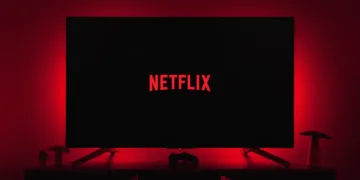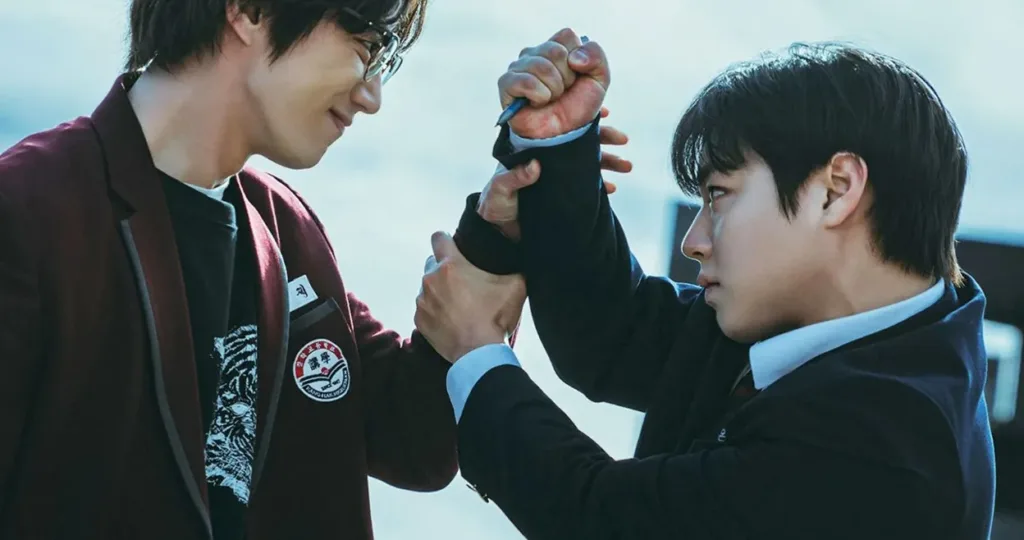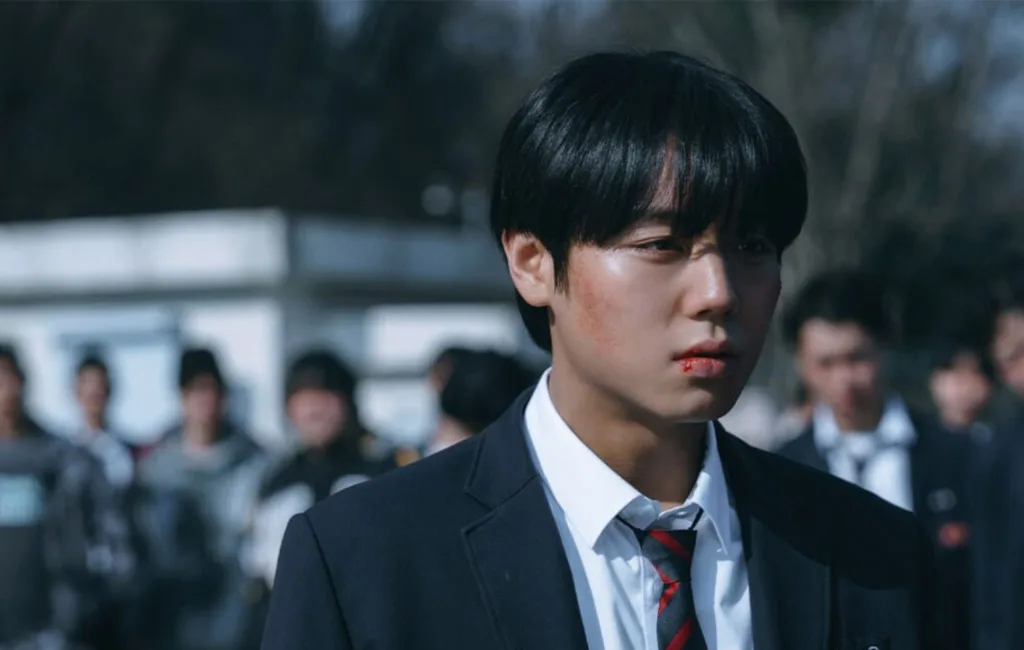Season 2 of Weak Hero Class 2 picks up immediately after Yeon Si‑eun’s forced transfer to Eunjang High, where rumor and reputation erect invisible walls around him. Once a top student, he now faces an entrenched hierarchy of teenage delinquency known as “The Union,” a self‑policed syndicate that thrives on borrowed authority and administrative neglect. Si‑eun’s gamble to stay invisible unravels the moment he witnesses a classmate’s public humiliation—his calculated intervention signals another round in a schoolyard war that mirrors broader struggles over power and voice.
The series marries Si‑eun’s internal monologue—measured, almost clinical—with staccato bursts of violence, underscoring the tension between introspection and action. Rooted in its Korean webtoon origins, this Netflix installment flaunts higher production values: spacious corridors convey isolation, while dynamic camera work amplifies each fight’s tactical choreography. Yet the show never loses sight of its social commentary: these hallways double as arenas where systemic bullying intersects with bystander silence.
Across eight episodes, Si‑eun’s transformation from reluctant observer to cautious ally unfolds alongside emerging figures like Seo Jun‑tae, Choi Hyo‑man, Park Hu‑min (Baku), Na Baek‑jin and the anarchic Geum Seon‑je. Their interactions sketch out alliances forged under duress, hinting at how solidarity can upend coercive power.
Momentum in the Hallway: Narrative Structure & Pacing
The eight‑episode arc moves with the precision of a well‑executed fight combo—each chapter establishes a new pressure point before releasing kinetic energy. Early installments linger on Si‑eun’s isolation, allowing viewers to register the emotional toll of systemic bullying. Mid‑season entries accelerate into coordinated skirmishes and alliance‑building, while the penultimate episodes widen the canvas for the climactic brawl. This calibrated alternation between reflection and action echoes a broader trend in streaming dramas: granting space for character psychology without sacrificing narrative momentum.
A slow‑motion fight montage over Si‑eun’s measured voiceover doubles as world‑building and social commentary. It frames Eunjang High as a microcosm of unchecked power and silent complicity, inviting viewers to confront how institutions enable abuse. By opening on humiliation in a stairwell, the series hooks an audience primed to question who bears responsibility when authority looks the other way.
Si‑eun’s calculated rescue of Seo Jun‑tae marks a tonal pivot from passive observation to reluctant intervention. This act triggers Park Hu‑min’s declaration—no more fights—upending the school’s fragile equilibrium. The ban on physical retaliation forces conflicts into subtler arenas of strategy, underscoring how oppressed groups innovate resistance when formal channels fail them.
The finale stages a strategic tag‑team assault against the Union, highlighting shifting allegiances born from necessity rather than ideology. Camera work tightens on hit‑and‑run tactics, then pulls back to reveal collective resolve. As power exchanges hands, the series nods to social movements that coalesce under shared grievance, illustrating that even the most atomized individuals can unite to dismantle entrenched hierarchies.
In the quiet aftermath at the school gate, Yeon Si‑eun’s internal narrative yields to an awakened Ahn Su‑ho, suggesting restorative possibilities beyond violence. A post‑credits glimpse of Na Baek‑jin’s uncertain fate leaves several doors ajar—an invitation to explore how accountability and redemption might evolve in Season 3, and whether systemic change can outlast episodic spectacle.
Character Alchemy: Faces of Resistance
Yeon Si‑eun (Park Ji‑hoon) inhabits a quiet storm. His internal narration, delivered in near-monotone calm, clashes with sudden eruptions of violence—an elegant metaphor for suppressed youth rage. Early scenes show him calculating force and momentum in his head before a single punch lands, each blink or tightened jawline betraying guilt and self‑doubt. As episodes progress, those micro‑expressions shift: isolation gives way to guarded trust, and the reluctant protector emerges in fleeting smiles shared with allies.
Seo Jun‑tae (Choi Min‑young) enters as the archetypal underdog—wide‑eyed, bookish, almost trembling under the weight of bullying. His first timid refusal to fight, followed by a hesitant stand, charts a powerful arc. In mirroring Si‑eun’s own journey, Jun‑tae embodies how solidarity can ignite latent courage, transforming a one‑note victim into an active agent of change.
Choi Hyo‑man (Yoo Su‑bin) thrives on swagger. Gold chains and sneers mark his public persona, yet in private he shrinks before shadowy Union figures—an ironic riff on performative power. YSB’s performance is a revelation; the bully’s bravado masks deeper insecurity, making Hyo‑man unexpectedly sympathetic.
Park Hu‑min/Baku (Ryeoun) feels like the show’s moral compass. He bans fights yet steps in with a grin and a slam‑dunk demonstration of solidarity. His easy rapport with Si‑eun shifts the dynamic from predator–prey to co‑conspirators, symbolizing friendship as resistance.
Na Baek‑jin (Bae Na‑ra) contrasts with Geum Seon‑je (Lee Jun‑young) in how they wield chaos. Baek‑jin’s cold precision and concealed pain drive the Union’s strategic moves, while Seon‑je’s manic unpredictability injects reckless energy. Their dueling backstories—one shaped by institutional neglect, the other by thrill‑seeking rage—fuel the season’s central conflict.
Brief cameos of Ahn Su‑ho in stasis and distracted adults underscore generational disconnect. Meanwhile, teachers drift through corridors as background props. It’s the student ensemble, from bookish allies to reluctant fighters, who build Eunjang High into a crucible for social commentary on youth agency and institutional failure.
Visual Dynamics: Cinematic Style & Direction
From the first frame, Weak Hero Class 2 stakes its claim on mood through striking slow‑motion sequences. A hallway scuffle unfolds in deliberate fractions of a second, forcing us to linger on each glint of a flying pen or the tense line of Si‑eun’s jaw. In tighter shots, corridors feel like pressure cookers—walls closing in—while occasional rooftop or courtyard scenes breathe with expansive depth, reminding us that even confined spaces can offer moments of escape.
The series favors a muted palette: Eunjang High’s grey uniforms echo institutional apathy, yet the bullies’ gold chains and vivid street art punctuate student resistance. Classrooms sag under peeling paint and discarded phones, subtle props that whisper of neglected authority and underground economies.
Han Jun‑hee’s choreography draws on lessons from D.P.—fights staged as tactical puzzles rather than chaotic brawls. Camera movement threads through hand‑to‑hand exchanges with fluid precision: a whip‑pan follows a kicked desk, then clings to an upraised textbook turned shield. Spatial awareness becomes a character in its own right, mapping every scuff, dodge and counter‑strike.
Recurring motifs—pens curved like blades, textbooks snapped like shields—reinforce the thesis that even ordinary objects carry transformative power. Visual nods to Newton’s laws surface in swinging light fixtures and the measured arc of a thrown backpack, underscoring a physics‑inspired moral code.
Throughout, Han balances a documentarian’s eye with stylized bursts of violence. Quiet moments are rendered in natural light and muted sound; then, in an instant, rapid cuts and pulsing score thrust us back into the fray. Such tempo shifts reflect how young people oscillate between introspection and action, mirroring broader cultural conversations about agency under pressure.
Calculated Conflict: Action & Choreography
From the opening solo skirmish where Si‑eun fends off two assailants with nothing but pens, to improvised weapon duels and multi‑person tag‑team clashes, Weak Hero Class 2 stages a spectrum of confrontations. Early episodes isolate fights in narrow corridors, heightening tension. By mid‑season, alliances coalesce into coordinated assaults on Union strongholds. The finale sprawls across courtyards and stairwells, transforming the school into a battlefield where every rostered student feels like a pivotal piece in a living chess match.
Bruises bloom under harsh lighting; sweat beads at necklines. When a textbook snaps against bone, you can almost hear cartilage protest. Yet at times the camera slows to savor an arc of flying debris or a fist’s decisive impact. That tension between raw grit and choreographed flourish reflects a wider trend in streaming action: visceral immediacy married to cinematic polish.
Si‑eun’s math‑driven combat offers more than flashy moves. He quotes Newton’s “mass × acceleration” while calculating counter‑force, turning everyday objects—flowerpots, stolen phones—into strategic instruments. One sequence finds him yanking a chair mid‑swing to thwart a bully’s overhead strike, demonstrating how intellect reclaims agency where brute strength fails.
Each blow resonates with regret. Guilt over past trauma fuels Si‑eun’s precision; protecting Seo Jun‑tae infuses punches with purpose. In these scenes, violence becomes a narrative device that reveals character layers rather than empty spectacle.
Netflix’s budget boost allows for dozens of extras in Union ranks and widescreen battle tableaux. While larger scope lends epic flair, some intimate moments—Si‑eun’s lone standoff in an empty hallway—retain their piercing impact, reminding us that even grand set pieces depend on a single compelling performance.
Battlegrounds of Power and Solidarity
Bullying in Weak Hero Class 2 transcends adolescent cruelty, rising to the level of institutional failure. Classrooms echo with ignored cries, while faculty avert their gaze—an indictment of administrative indifference that mirrors real‑world debates over school safety. The “Union,” a teen‑run criminal network, cements that dynamic: hierarchy enforced by whispered threats and stolen phones.
Rumors of Si‑eun having “killed a kid” act as social armor, warding off initial attacks. This phenomenon—protective walls built on misinformation—underscores how power can shift through reputation alone. In this peer‑to‑peer governance, students police each other while adults remain passive, exposing gaps in accountability that resonate beyond the screen.
Si‑eun’s arc charts a path from self‑preservation to reluctant ally. His invocation of Newton’s third law—every action met with equal and opposite reaction—serves as both battle plan and moral compass. Violence becomes a calculated response to injustice rather than mindless rage.
Friendship under duress emerges as the season’s emotional core. The Eunjang trio forges solidarity born of necessity, contrasting with the fractured bonds of Season 1. Meanwhile, Baku and Baek‑jin’s tragic drift evokes universal themes of loyalty’s cost.
Halls designed for learning morph into survival arenas, highlighting paradoxes of academic pressure and social stratification. In transforming education into conflict space, the series challenges viewers to rethink where students find real authority—and whether traditional systems can ever protect the vulnerable.
Full Credits
Director: You Su-min
Cast: Park Ji-hoon, Choi Hyun-wook, Hong Kyung, Kim Su-gyeom, Lee Yeon, Shin Seung-ho, Hwang Sung-bin, Cha Woo-min, Jo Han-chul, Yoon Jung-Hoon, Na Chul, Ryeoun, Choi Min-yeong, Bae Na-Ra, Lee Min-Jae, Lee Jun-young, Yuuki Luna, Lorna Duyn, Yoo Su-bin, Jeon Bae-soo, Andy Luu, River Ramos, Jang Dae-woong, Jo Ah-young, Kim Tae-joon, Park Sang-eun, Jo An-young, Jonathan Tanigaki, Yu Seong-yong
The Review
Weak Hero Class 2
With its incisive examination of youth agency and polished action sequences, Weak Hero Class 2 transforms a familiar revenge drama into a social allegory that feels urgent and relevant. Moments of grandeur sometimes overshadow private struggles; yet strong performances and thematic focus sustain its impact.
PROS
- Sharp social commentary on bullying and institutional neglect
- Dynamic fight choreography that balances strategy with grit
- Nuanced performances, especially Park Ji‑hoon’s restrained intensity
- Effective use of introspective voiceover to deepen character insight
- Elevated Netflix production values enhance visual impact
CONS
- Expansive action sometimes sidelines intimate character moments
- Large ensemble of new characters can dilute individual arcs
- Certain plot threads feel rushed within eight episodes
- Emotional beats occasionally overshadowed by spectacle


















































